If you’ve ever heard of tonglen meditation, it’s likely you’ve dipped your toe into the contemplative waters of Buddhism. I learned tonglen from a former Buddhist monk during a 6-week telecourse on mindfulness and meditation.
It’s an ancient Buddhist meditation practice known to awaken empathy and compassion in the hearts and minds of those who practice it regularly.
What I love about it is that it helps me get out any sort of selfish, “poor me” state I might be in, taking me outside of myself and into a state of caring for others.
One might say this is the contemplative practice we need in the West, to get us out of our “me first,” individualistic mentality, transforming us into a more compassionate, empathetic, and more deeply human society.
Pema Chodren, the most famous Buddhist teacher in the West, is a huge proponent of the Tonglen practice, also known as the “taking and sending” meditation. She practices it herself often, and teaches it to her students.
Read: Awakening Through the Teachings of the Buddha
What Is Tonglen?
In Tonglen, we take in the pain of others on an in breath, and send out healing vibes and thoughts on our out breath.
As you can already see, without practicing it, this is the opposite of what we tend to do—especially when we ourselves are in pain. Whether we’re experiencing pain or suffering in any given moment, this a beneficial practice to do.
It takes us out of our small selves and opens us up to a state of deep open-heartedness.
One of the central teachings of yoga and Buddhism is that we humans suffer because we’re constantly seeking pleasure.
We want things to be “good.” We want to feel “good.”
But life is full of suffering and rather than accepting it and being with it, we tend to run away from it whenever it happens. Tonglen helps us learn to sit with the suffering of others, and reverse the usual pleasure seeking we’re so prone as humans to chase.
You don’t have to feel guilty if this practice feels strange to you at first. It’s in our DNA to be selfish. Survival of the fittest, right? So, it stands to reason that this practice may seem strange or uncomfortable.
Cut yourself some slack and ease your way into it. It will take quite a bit of practice before you actually open yourself up to the opposite of what you’re used to doing—the deeply ingrained patterns of worrying about yourself and those in your immediate environs.
Read: Focus On What You Want Versus What You Don't Want
With time, however, the Tonglen practice will begin working its magic on you. And you may find it becomes your go-to meditation practice.

How to Practice Tonglen
As with any meditation practice, find yourself a comfortable position—one you can easily sustain for at least 15 minutes. This can be sitting cross-legged on a cushion, sitting in a chair with your back straight and your feet planted firmly on the floor, or even lying down with a blanket over you to keep you warm.
The most important thing is that you’re at ease.
Now, you’re going to bring into your mind’s eye someone who may be suffering.
This person could be someone close to you, an acquaintance, or a total stranger. It could be an individual or a group of people.
The pain might be extreme and physical, like someone suffering from an illness, or the pain could be more subtle and more psychological and emotional—like someone going through a transition phase in their life that’s somewhat turbulent.
It might be someone who’s been acting irritated and crabby lately, and you know something’s going on with them, but you’re not sure what. Everyone suffers in some way or another at any given time, and the suffering may be big or small. Whatever it is, and whoever’s pain it is, you’re going to bring it into your mind’s eye now.
Next, breathe that pain into your being, and do it on an inhale.
It’s as if you’re physically and energetically pulling that person’s (or persons’) pain into yourself, so that they no longer have to carry the burden.
Pretty selfless, right? And also the opposite of what you’re used to doing. This might seem counterintuitive, but just stick with it.
The next step happens on your exhale. On the exhale you send whatever you think will be of benefit to them—whatever will help take away their pain.
You might visualize a healing white light washing over this person or persons. Maybe you simply think the thought, “take their pain away.” Perhaps you simply breathe out a feeling of lightheartedness.
Again, breathe in their pain. Be with it. It may feel dark. It may feel claustrophobic. It may be intense, and heavy. Just be with it in a vast and open heart-space. Take it all in. Feel the negative energy. Let it seep into your bones.
Now, exhale. As you do, send out all the love you have to the person or persons. See them feel lighter, and less burdened by the heaviness of their suffering. Be with this extension of your healing intention, until it’s time to repeat the cycle.
Inhale pain. Exhale healing.
Do several rounds of this until you feel it’s complete.
Read: Meditation & Mindfulness: What's the Difference?
Enjoy tonglen, and try it for a week. Before long, you may find it comes quite naturally to you. Delight in doing something different. It feels really freeing when you do!
During These Times of Stress and Uncertainty Your Doshas May Be Unbalanced.
To help you bring attention to your doshas and to identify what your predominant dosha is, we created the following quiz.
Try not to stress over every question, but simply answer based off your intuition. After all, you know yourself better than anyone else.